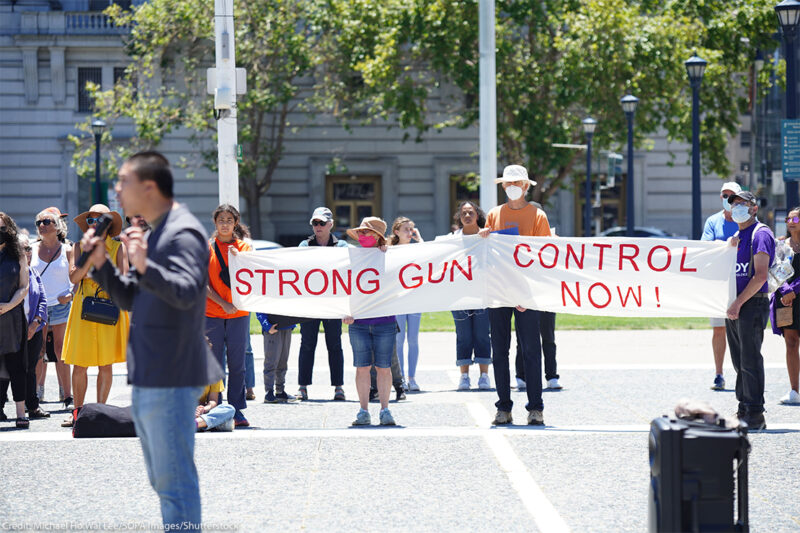The Supreme Court's Gun Decision Is Not a Victory for Women


This piece was first published in Slate on 6/21/24.
The U.S. Supreme Court today broke from its recent embrace of gun rights, leaving in place a federal criminal law that makes it a felony for anyone subject to a civil domestic violence restraining order to possess a gun.
As an advocate for survivors of domestic violence, today’s outcome comes as a relief. Indeed, it is the result my organization, the ACLU, asked the court to reach.
Even so, liberals shouldn’t take the decision as cause for great celebration. That’s because, while there is no doubt in my mind that preventing perpetrators of domestic violence from obtaining guns will help prevent further violence, this case was not about whether the respondent should have been able to buy a gun. The question was whether he should be sent to prison for having one.
As a feminist, I care about both gender-based violence and the violence of imprisonment. Gun laws, in particular, have helped to fuel mass incarceration and contributed to disproportionate imprisonment of Black people and other people of color.
Funneling the problem of gender-based violence into the criminal legal system may not sound so bad if the alternative is no response at all. That’s the problem the court faced in United States v. Rahimi. But that’s a false choice, constructed via decades of reliance on criminal legal responses to violence in America’s legislatures, executive branches, and state and federal courts.
The Supreme Court itself has played a part in creating this dilemma. In 2000, for example, the court heard a case brought by a survivor against a college classmate whom she alleged had raped her repeatedly. She was able to sue her attacker because of a novel provision of the Violence Against Women Act that empowered survivors to seek a civil remedy from those who harmed them.
The court, however, made quick work of VAWA’s civil provision, finding that Congress lacked the power to create any such remedy at all. But it left in place criminal provisions carrying lengthy terms of imprisonment. Stripped of its civil provision, the original VAWA became known not as an innovative law but a regressive one—and part of the notorious 1994 crime bill.
A second decision in 2005 doubled down. After her estranged husband violated a restraining order and kidnapped her three kids from her yard, Jessica Lenahan (then Gonzales) contacted police multiple times over 10 hours asking them to help retrieve her children. Police refused, saying there was nothing they could do—until the father arrived at the police station and opened fire. Only then did the police act, killing Lenahan’s husband and finding the children already dead in his truck.
Lenahan sued the police, but she didn’t fare any better in the courts. Looking to history and tradition, the Supreme Court couldn’t find any right to have her restraining order enforced. What it did find was a “well established tradition of police discretion.” This history, the court noted without irony, meant that the state was free to both disregard survivors like Lenahan who asked police for help and bulldoze over survivors who asked the state not to interfere in cases of domestic assault.
Viewed in the context of the court’s history with domestic violence, survivors should think twice before embracing today’s decision as a victory for women. It can be understood not as a departure from the VAWA and Lenahan decisions, but a continuation of them: In all three cases, the only winner was the carceral system.
Our nation’s prioritization of the criminal legal system to the exclusion of all else is particularly troubling given that many people who experience domestic violence opt not to pursue criminal charges, knowing that they may encounter disbelief and hostility from law enforcement or find themselves subject to abuse charges when they report being victimized. Others worry that the criminal legal system will magnify the harms they are experiencing by jeopardizing their family’s economic security or inflicting further violence through incarceration. As feminist legal scholar Aya Gruber has written, hyperfocus on the criminal legal system has “diverted feminist energy and capital away from addressing the underlying conditions that make women, especially marginalized women, vulnerable to personal and state violence.”
But we can advocate for alternate pathways to meaningful safety.
There is not strong evidence to support the deterrent effect of after-the-fact criminal sanctions for gun possession, yet such punishments are where Congress has focused. The civil licensing regime that prohibits selling guns to people in Rahimi’s position, for example, exists only as a piggyback measure off of the underlying criminal law.
As the ACLU pointed out in a friend-of-the-court brief, that add-on has prevented more than 77,000 gun sales since 1998. Congress would be wise to decouple gun sales from criminal law and to focus more on prevention—particularly given the likelihood that the court may soon void other criminal gun laws, with staggering ripple effects on rules governing gun sales.
Other efforts may include imagining new civil remedies for harms once considered exclusively criminal. The civil process, unlike the criminal one, can offer survivors agency: the decision whether and when to seek relief and the option to discontinue the case if that best serves their needs. To ensure equitable access to courts, attorney’s fees and other incentives to represent survivors can be built in.
Reimagining safety is possible, but only if we reject the idea that prison is the best—or the only—way to address domestic violence. Survivors deserve better than what the carceral legal system has left us. We all do.
Donate to the ACLU
The ACLU has been at the center of nearly every major civil liberties battle in the U.S. for more than 100 years. This vital work depends on the support of ACLU members in all 50 states and beyond.
We need you with us to keep fighting — donate today.
Contributions to the ACLU are not tax deductible.



